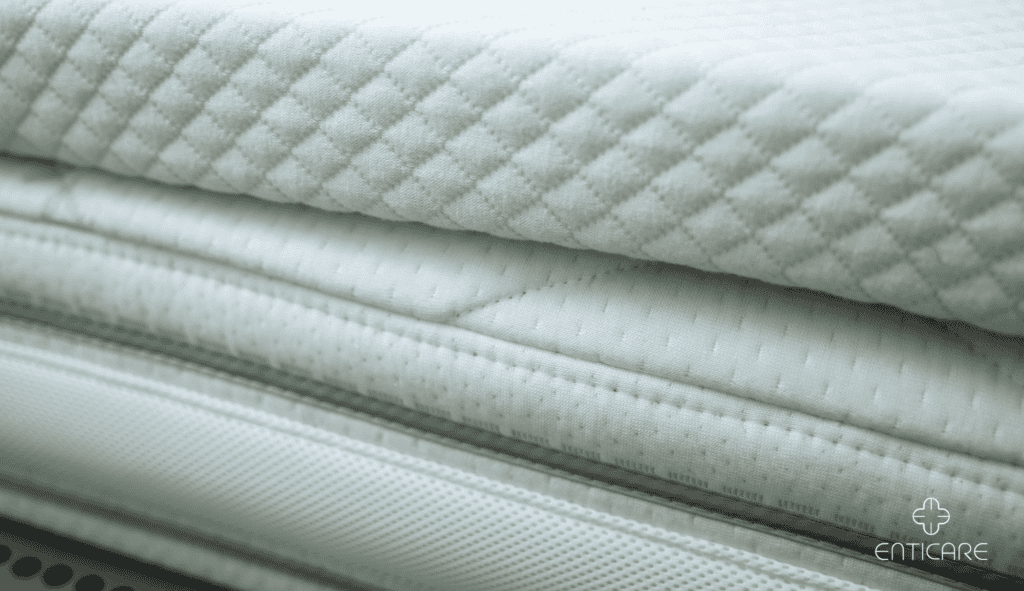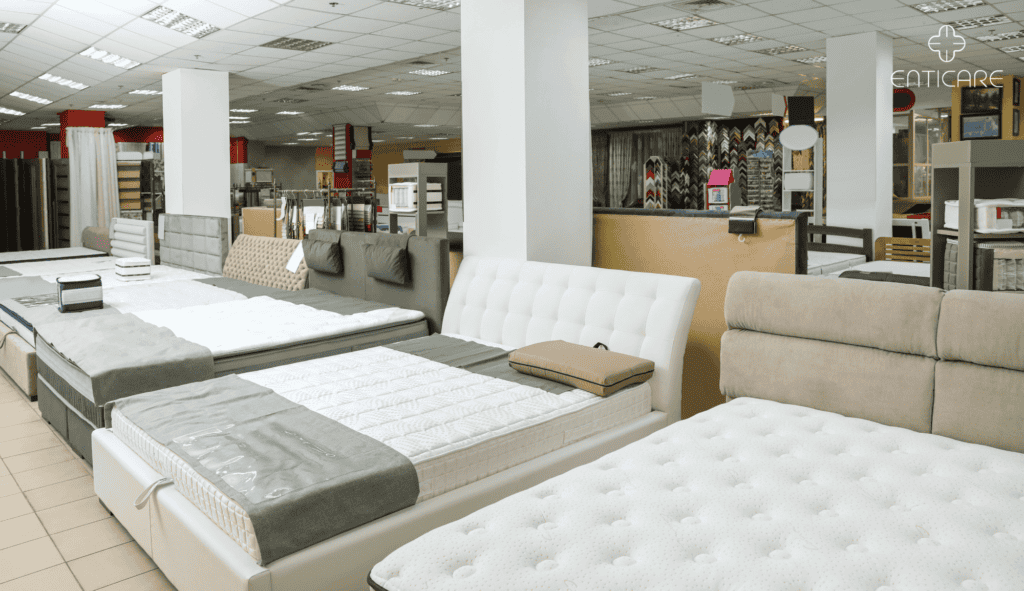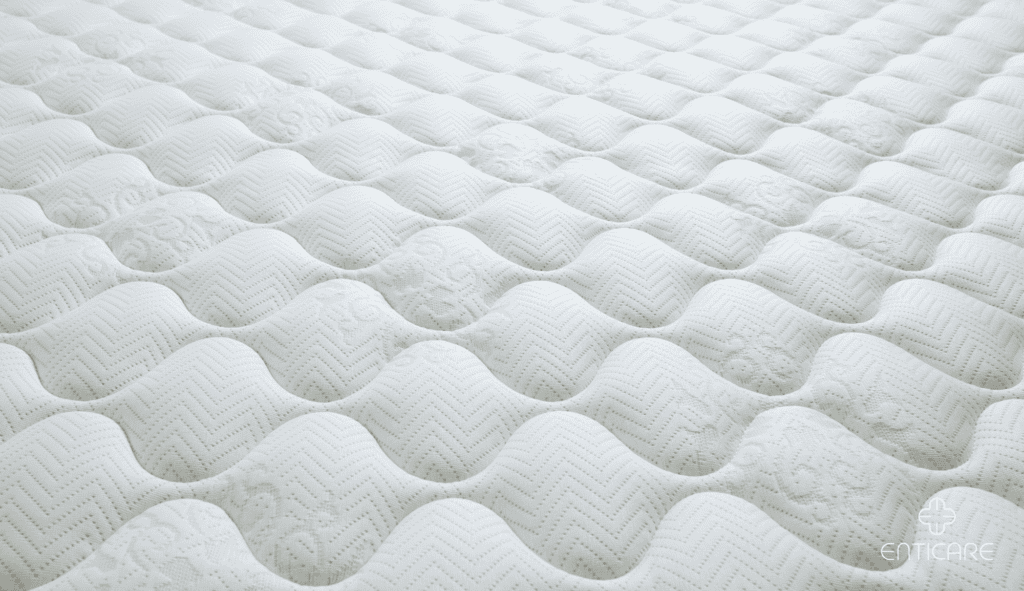Everyone deserves restful, undisturbed sleep, but for many, the nightly battle with snoring and sleep apnea interrupts that peace. Many people search for solutions in diet, lifestyle, or medical interventions. Yet, one often overlooked factor significantly affects both snoring and sleep apnea: your mattress. Did you know that choosing the right mattress could make a world of difference in how well you breathe at night? A supportive mattress is crucial for achieving a good night’s sleep, as it can alleviate issues such as back pain and ensure proper body alignment, ultimately contributing to a restorative good night’s sleep.

The Connection Between Mattress Support and Airflow
A mattress does more than provide comfort; it also plays a crucial role in supporting your posture and airway during sleep, which is essential for managing sleep disorders like obstructive sleep apnea. A supportive mattress can help maintain proper body alignment, reduce discomfort, and ultimately contribute to achieving a restorative good night’s sleep.
Spinal Alignment and Airway Health
A proper mattress promotes spinal alignment, which in turn keeps your airway open. When your spine falls out of alignment, the tissues in your throat may collapse, narrowing your airway. This can cause or worsen snoring and sleep apnea. A mattress that allows your body to sink too far may compress your airway, while one that’s too firm may misalign your neck and shoulders. Proper spinal alignment can help ease sleep apnea symptoms by maintaining airway openness during sleep.
Head and Neck Positioning and Sleep Posture
The head’s positioning directly impacts airflow. A mattress that provides even pressure across your body helps keep your head and neck in an optimal position for breathing. If your mattress tilts your neck at odd angles or fails to support it correctly, airflow can become restricted, leading to snoring or sleep apnea events.
Pressure Relief and Relaxation
A good mattress supports pressure relief, especially around key areas like the neck, shoulders, and hips. When muscles are tense due to discomfort from a poor-quality mattress, this tension can extend to the throat, causing partial airway obstruction. High-quality materials like memory foam or latex can provide the right balance of comfort and support, leading to better breathing patterns throughout the night.

Firmness: Striking the Right Balance
Not all mattresses are created equal, and neither is everyone’s snoring or sleep apnea. Mattress firmness matters, but finding the right level depends on your unique sleep needs.
A luxury hybrid mattress provides the right balance of firmness and support, making it an excellent choice for those seeking premium quality and advanced features.
Too Firm and Too Soft: What’s the Problem?
If your mattress is too soft, your body might sink excessively, pulling your spine out of alignment and compressing your airways. On the flip side, a mattress that’s too firm can push your neck and back into unnatural positions, also restricting airflow. Both extremes can aggravate snoring and sleep apnea.
Medium-firm mattresses for Optimal Support
Experts recommend a medium-firm mattress for most people dealing with snoring or sleep apnea. This balance allows enough contouring to relieve pressure without letting your body sink too deeply. It helps keep your spine aligned, which is key for maintaining open airways while you sleep .
Customizable Mattresses
For those with specific needs, some mattresses come with adjustable firmness levels, allowing you to find the perfect balance for your body. This customization ensures you get just the right amount of support to keep your airways clear and reduce the chances of snoring.
Mattress Materials Matter
The materials in your mattress also influence how well it supports your breathing during sleep. The wrong material can trap heat, aggravate allergies, and fail to support your body correctly.
Memory Foam Mattress
Memory foam mattresses conform to your body, which can support proper spinal alignment. However, they also tend to trap heat, and sleeping hot can make sleep apnea symptoms worse by causing frequent awakenings. To combat this, look for memory foam mattresses infused with cooling technologies or opt for hybrid models with improved airflow.
Latex
Latex mattresses are naturally cooling and responsive. They offer good support for your back and neck while maintaining breathability. Latex is also hypoallergenic, which is crucial for people whose allergies contribute to their snoring.
Hybrid Mattresses
A hybrid mattress combines the best of both worlds, offering the contouring benefits of foam and the structural support of innerspring coils. This combination often creates the right environment for improved breathing and reduced snoring.
Mattress Age and Sleep Apnea
Even if you start with the perfect mattress, time wears down its effectiveness. Old mattresses can increase the risk of developing obstructive sleep apnea due to reduced support.
Sagging and Spinal Misalignment
Over time, mattresses begin to sag, especially in areas where you frequently sleep. This sagging can lead to improper spinal alignment, which compresses airways and can worsen sleep apnea symptoms.
Loss of Firmness
As your mattress ages, it loses its firmness. Even if you chose a medium-firm mattress initially, it may not retain its shape and support after years of use. A mattress should generally be replaced every 7-10 years to ensure you’re getting the support you need to keep your airways open during sleep.
Increased Exposure to Allergens
Old mattresses tend to accumulate allergens like dust mites, which can trigger allergies or asthma, further exacerbating snoring. If your snoring worsens over time, consider whether an old mattress might be to blame.

Mattresses for Side Sleepers
Sleeping position is crucial for sleep apnea sufferers, as it can significantly impact symptom severity. Sleeping on your side is often recommended for people with sleep apnea, as it reduces the likelihood of airway collapse. Choose a mattress that contours well to your body while supporting side-sleeping positions. Memory foam and latex mattresses are excellent options for side sleepers with sleep apnea.
Mattresses for Back Sleepers
While back sleeping often exacerbates snoring and sleep apnea, some individuals find it more comfortable. If you prefer sleeping on your back, choose a mattress with firmer support to prevent your body from sinking too much, keeping your spine aligned.
Adjustable Beds for Sleep Apnea
Adjustable beds, where the head can be elevated, can help reduce sleep apnea symptoms by keeping the airway open. If your budget allows, consider pairing a good mattress with an adjustable bed frame to enhance the benefits further.
Take Action for Better Sleep
Your mattress plays a pivotal role in your ability to breathe well at night. From supporting your spine to maintaining optimal airflow, choosing the right mattress can significantly reduce snoring and sleep apnea symptoms. Whether you need a new mattress to correct spinal misalignment or simply want to explore customizable options, the right decision can drastically improve your quality of life.
Are you struggling with snoring or sleep apnea? A new mattress might just be the solution you’ve been searching for. Take the next step toward better sleep and schedule a consultation with our experts at Enticare Sleep Solutions today. Don’t let poor sleep quality affect your life any longer – start your journey to restful nights and better health!

